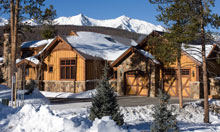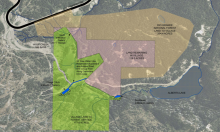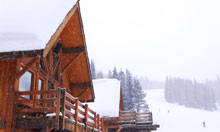The True History
The Wolf Creek Ski Area is a treasure for Mineral County and Southern Colorado.
Many years ago an effort began to create a truly unique, enhanced outdoor and wilderness experience to complement the Ski Area so that the area could be enjoyed by more people and provide badly needed jobs for the region. Despite these efforts to bring to life a decades-long dream of a high-quality boutique base village at Wolf Creek, environmental groups from outside the tri-county region surrounding Wolf Creek fought these efforts through litigation and an avalanche of misinformation. This is the “True Story” of the Village at Wolf Creek.
First, the land at the base of Wolf Creek is private land and has been private land for over 30 years. It is not public land, nor Forest Service land. No court has ever ruled that it is not private land. No court has held that the project cannot be built. No court has held that the owners are not entitled to access their land. As is the case with any private land, the owners have the right to decide how to use it. Second, the only dispute about this land – and the only impediment to the realization of the project – is the need for a road to access the property. That is all that the litigation has been about: how to best access the property, not whether it will be developed. Federal law absolutely entitles the owners of private land surrounded by public land adequate access to their property. Since the project was first envisioned, the federal government has always held that use of this property as a base village is reasonable and no court has ever questioned that. Eventually, road access will be granted and construction will start. However, the litigation brought by these groups will make it more expensive and has successfully delayed the project, to the detriment of the local residents, workers, and families who will benefit from the development.
What Was Originally Planned Actually Got Smaller
The opponents of Wolf Creek claim that the development as now proposed is much larger than originally planned. That is simply not true. Before the land exchange was closed in 1987, the owners hired Sutherland Fallen, a land-planning firm from Aspen that developed a new plan for a resort of 2,151 units. That plan was submitted to the Forest Service and Mineral County prior to the land exchange closing. Furthermore, the following brochure was widely distributed to the public at that time showing a rendition of the 2,151-unit plan.
View the Century 21 Marketing Brochure.
Therefore, the opponents are wrong to say that the Village, as now proposed, is larger. The 2010 plan that was recently studied by the Forest Service actually projected just over 1,700 units.
The Present Years
In 2010, the owner proposed a land exchange to trade part of the skiable terrain, the Alberta lift area, and the wetlands back to the Forest Service for land that touched the highway and would give the project its necessary access. The owner and local stakeholders believed then and still believe today that a land exchange would benefit everyone, including the Ski Area and its skier-customers, as well as the environment, with the wetlands being returned to the public. The land exchange could have been pursued either administratively through the Forest Service or through land exchange legislation, which is often used to expedite such an exchange. The opponents did not want legislation and argued for an administrative exchange. The owner wanted to do both because there was concern that after the administrative exchange, the opponents would simply file another lawsuit to try to delay the favored exchange.
In February 2010, Colorado’s U.S. Congressman John Salazar held a meeting in Alamosa in an attempt to reach a resolution between the parties. Understanding the arguments on both sides, Salazar obtained commitments from everyone (including the owner and the opponents) to abide by the Forest Service’s decision on the administrative land exchange and not sue if Congressman Salazar would defer the legislation process.
To be specific, at Congressman Salazar’s meeting, Colorado Wild’s executive director, Ryan Bidwell, told Congressman Salazar in front of all of the present stakeholders that Colorado Wild would accept the Forest Service’s findings after the Forest Service conducted a new Environmental Impact Statement. Subsequently, in 2011, Colorado Wild’s subsequent-acting executive director, Paul Joyce, said that he “supports the Forest Service’s decision to conduct a full-blown Environmental Impact Statement and that he is willing to live with the results of that study.” Paul said that, “If at the end of the day Leavell McCombs gets their deal, then they get their deal. So be it.”
Relying on the false representations of the opponents, the owner relinquished his efforts to pursue a legislative exchange and submitted an application to the Forest Service for a new Environmental Impact Statement to analyze both a land exchange alternative and an easement access alternative in June 2010.
Commencing shortly thereafter, the Forest Service and its third-party consultant conducted a thorough and extensive Environmental Impact Statement analysis that took a “hard look” at all aspects of the proposed private land development. The analysis considered the affected environment, the environmental consequences, and the purpose and need for the Environmental Impact Statement. All science and data that was collected, analyzed, studied, and reviewed by the Forest Supervisor provided the necessary information to make a fully informed decision on the selection of an alternative to provide the legally entitled access to the private property.
In 2012, the Forest Service issued a Draft Environmental Impact Statement that thoroughly analyzed three separate alternatives: a land exchange alternative, a road access alternative, and a no-action alternative. During the public comment period that followed, over 900 public comment letters were provided to the Forest Service in support of, and in opposition to, the Land Exchange Alternative. The majority of the submitted public comment letters were from locals who favored the land exchange, private property rights, and the economic benefits associated with a tourist destination resort! Those sending support letters included local business owners, the three Counties closest to the project, Wolf Creek Ski Area, local towns, local chambers of commerce and local economic development groups. To this very day, however, the opponents from areas outside of the tri-county area continue to misrepresent the truth by suggesting that the locals are against the land exchange and the project, which is contrary to the comments received in the current Environmental Impact Statement.
In 2014, the Forest Service issued the Final Environmental Impact Statement and its draft Record of Decision selecting the land exchange as the preferred alternative. After a public objection period ended, months passed before the Forest Service issued its Final Record of Decision. During this time, the owner grew frustrated after the Forest Service kept promising to render a final decision that repeatedly failed to materialize. The owner’s development team continued to question the Forest Service at the regional and national level to ascertain when the final decision was going to be issued, but contrary to the opponents’ false accusations, there was no efforts by the owner or his representatives to influence the outcome of the decision. In fact, the Forest Service had already concluded months earlier in the draft decision that the land exchange was the preferred alternative. The Final Record of Decision selecting the Land Exchange Alternative was finally issued in May 2015.
After the Final Record of Decision was issued, the owner and the Forest Service closed the land exchange. Unfortunately, even though the land exchange was preferred by the majority of locals, the opponents (true to their character) broke their commitment to the owner, the Ski Area, the Forest Service, and the local jurisdictions who were present at Congressman Salazar’s February 2010 meeting and filed suit in U.S. District Court challenging the Forest Service’s land exchange decision and process.
To this day the opponents continue to mischaracterize material facts concerning the U.S. District Court’s decision. The court found no evidence of undue influence by the owner or his representatives in regards to the Forest Service process. The court also rejected the opponents’ arguments that the federal law guaranteeing access to the property did not apply in Colorado. The court also failed to find any flaw in the Environmental Impact Statement analysis or in the science supporting it.
Unfortunately, the court found that the Forest Service had incorrectly based its decision in the Final Record of Decision on a presumption that it lacked leveraged control over a private development in a land exchange. The court did not find that the land exchange alternative was wrong, just that some of the technical decision-making explained by the Forest Service in its decision on the exchange was wrong. Still believing in the benefit of the land exchange to the local communities, the general public, and to the Ski Area, the owner has appealed the court’s decision to the Tenth Circuit Court of Appeals. That case is still pending and will continue until the Court of Appeals decides the matter.
The opponents, who lied in 2010 and broke their commitment to accept the decision of the Forest Service, have delayed the owner his adequate access and the land exchange that was preferred by the Ski Area and the local communities. The owner and his development team recently redesigned the project and met with the Ski Area ownership to ensure that the project is compatible with the experience at Wolf Creek. Our ownership remains steadfastly committed to building a quality development that has the support of the Ski Area ownership and will economically benefit the local communities.
It is not a question of whether the legally required access will be granted to the owner of the private land, only when the access will be granted. The only outcome will be legal adequate access to the in-holding of private land, which will provide for an exceptional project for the benefit of the true locals and recreational public land users.


Frequently Asked Questions
Learn more about The Village at Wolf Creek.

The Opposition
This is NOT your local grass-roots coalition fighting against the project.

News and Press
Read new articles and press realeases about the Village.

